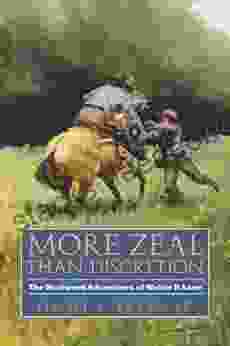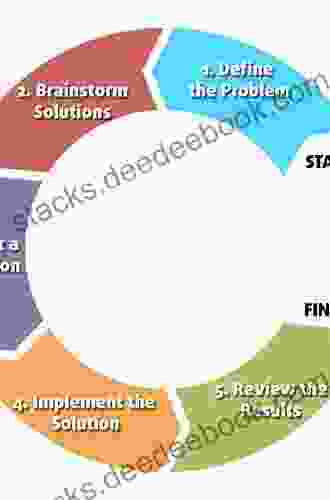Computer-Based Problem Solving Process

By Jayson Miller
In the ever-evolving world of technology, problem-solving has become an indispensable skill. With the advent of computers, the problem-solving process has undergone a significant transformation, enabling us to solve complex problems more efficiently and effectively.
In this comprehensive guide, we will delve into the intricacies of computer-based problem solving, providing you with a step-by-step framework to tackle problems systematically and develop robust solutions. By mastering this process, you will become proficient in utilizing computers as powerful tools for solving a wide range of problems.
5 out of 5
| Language | : | English |
| File size | : | 5806 KB |
| Text-to-Speech | : | Enabled |
| Enhanced typesetting | : | Enabled |
| Print length | : | 368 pages |
| Paperback | : | 30 pages |
| Item Weight | : | 3.84 ounces |
| Dimensions | : | 8.5 x 0.08 x 8.5 inches |
| Screen Reader | : | Supported |
1. Problem Analysis
The first and most crucial step in computer-based problem solving is problem analysis. This involves understanding the problem statement thoroughly, identifying the input and output requirements, and determining the constraints and limitations.
To effectively analyze a problem, ask yourself the following questions:
- What is the problem I am trying to solve?
- What are the inputs and outputs of the problem?
- Are there any constraints or limitations that I need to consider?
By thoroughly analyzing the problem, you can gain a clear understanding of its scope and requirements, setting a solid foundation for developing an effective solution.
2. Algorithm Design
Once you have a clear understanding of the problem, the next step is to design an algorithm to solve it. An algorithm is a step-by-step procedure that defines the logic for solving a problem.
When designing an algorithm, consider the following guidelines:
- Start with a high-level overview of the algorithm.
- Break down the problem into smaller, manageable subproblems.
- Develop a logical sequence of steps to solve the subproblems.
- Consider the efficiency and accuracy of the algorithm.
By carefully designing an algorithm, you can ensure that your solution is efficient, reliable, and scalable.
3. Coding
Once the algorithm is designed, it needs to be translated into a programming language so that the computer can understand and execute it. This process is known as coding.
When coding, it is essential to adhere to the following best practices:
- Use a clear and concise programming style.
- Document your code thoroughly.
- Test your code regularly to ensure its correctness.
By following these guidelines, you can produce high-quality code that is easy to understand, maintain, and debug.
4. Testing
Testing is a crucial step in computer-based problem solving. It involves verifying that the program produces the correct output for a given set of inputs.
To effectively test a program:
- Develop a set of test cases that cover a wide range of inputs.
- Run the program with the test cases and compare the actual output to the expected output.
- Analyze the results and identify any errors or discrepancies.
By thoroughly testing your program, you can ensure its reliability and accuracy.
5. Debugging
Debugging is the process of identifying and fixing errors in a program. When a program does not produce the correct output, it is essential to debug it to find the source of the problem.
To effectively debug a program:
- Examine the error messages and stack traces.
- Use debugging tools to step through the program and identify the point of failure.
- Analyze the code and identify the logical errors or coding mistakes.
- Make the necessary corrections and re-test the program.
By systematically debugging your program, you can resolve errors and ensure that it functions as intended.
6. Optimization
Optimization is the process of improving the performance and efficiency of a program. Once you have a working program, you can optimize it to make it run faster, use less memory, or handle larger inputs.
To optimize a program:
- Identify the performance bottlenecks.
- Analyze the code and identify areas for improvement.
- Implement optimizations to improve the performance.
- Re-test the program to verify the improvements.
By optimizing your program, you can ensure that it performs at its best and meets the performance requirements.
Mastering the computer-based problem solving process is essential for effectively solving problems using computers. By following the steps outlined in this guide, you can develop robust solutions, write efficient code, and optimize your programs to achieve optimal performance.
Remember, problem-solving is a continuous learning process. The more you practice, the better you will become at it. Embrace challenges, experiment with different approaches, and不断学习 to enhance your problem-solving abilities.
With dedication and perseverance, you can become an expert problem-solver, capable of tackling even the most complex problems with confidence and efficiency.
5 out of 5
| Language | : | English |
| File size | : | 5806 KB |
| Text-to-Speech | : | Enabled |
| Enhanced typesetting | : | Enabled |
| Print length | : | 368 pages |
| Paperback | : | 30 pages |
| Item Weight | : | 3.84 ounces |
| Dimensions | : | 8.5 x 0.08 x 8.5 inches |
| Screen Reader | : | Supported |
Do you want to contribute by writing guest posts on this blog?
Please contact us and send us a resume of previous articles that you have written.
 Book
Book Novel
Novel Chapter
Chapter Genre
Genre Library
Library Paperback
Paperback Magazine
Magazine Newspaper
Newspaper Sentence
Sentence Bookmark
Bookmark Glossary
Glossary Bibliography
Bibliography Foreword
Foreword Footnote
Footnote Scroll
Scroll Codex
Codex Tome
Tome Bestseller
Bestseller Narrative
Narrative Biography
Biography Autobiography
Autobiography Reference
Reference Character
Character Resolution
Resolution Librarian
Librarian Catalog
Catalog Card Catalog
Card Catalog Borrowing
Borrowing Archives
Archives Study
Study Reserve
Reserve Academic
Academic Journals
Journals Literacy
Literacy Thesis
Thesis Dissertation
Dissertation Storytelling
Storytelling Reading List
Reading List Book Club
Book Club Theory
Theory Thomas N Mcinnis
Thomas N Mcinnis Mark Lines
Mark Lines Ola Gjeilo
Ola Gjeilo Wayne Ng
Wayne Ng William Briggs
William Briggs Sarah Lark
Sarah Lark Elizabeth Chadwick
Elizabeth Chadwick Daniel Farcas
Daniel Farcas Brad Vanauken
Brad Vanauken Laura Carno
Laura Carno Mary Sebastian
Mary Sebastian Michael J Shapiro
Michael J Shapiro Christopher Hauke
Christopher Hauke Mandy Concepcion
Mandy Concepcion Honor Raconteur
Honor Raconteur Ms Annie Baker
Ms Annie Baker Marie Howe
Marie Howe Gayle Trotter
Gayle Trotter Vlado Damjanovski
Vlado Damjanovski Rachel Burns
Rachel Burns
Light bulbAdvertise smarter! Our strategic ad space ensures maximum exposure. Reserve your spot today!
 Pete BlairFollow ·15k
Pete BlairFollow ·15k Dwight BellFollow ·15.8k
Dwight BellFollow ·15.8k Duncan CoxFollow ·11.3k
Duncan CoxFollow ·11.3k Damon HayesFollow ·10.8k
Damon HayesFollow ·10.8k Jay SimmonsFollow ·6.2k
Jay SimmonsFollow ·6.2k Cole PowellFollow ·2.7k
Cole PowellFollow ·2.7k Vince HayesFollow ·11.8k
Vince HayesFollow ·11.8k Henry Wadsworth LongfellowFollow ·14.1k
Henry Wadsworth LongfellowFollow ·14.1k

 Amir Simmons
Amir SimmonsMore Zeal Than Discretion: A Closer Look at the Risks and...
Enthusiasm is often seen as a positive...

 Wayne Carter
Wayne CarterYear of the Dog: American Poets Continuum 178
Year of the Dog is a...

 David Foster Wallace
David Foster WallaceThe Constitution of the State of New York: A...
The Constitution of the...

 Harvey Bell
Harvey BellSmall Cetaceans of Japan: Exploitation and Biology
Small cetaceans, including...

 Blake Bell
Blake BellEffortless Elegance: A Comprehensive Guide to Captivating...
In the realm of crocheting,...
5 out of 5
| Language | : | English |
| File size | : | 5806 KB |
| Text-to-Speech | : | Enabled |
| Enhanced typesetting | : | Enabled |
| Print length | : | 368 pages |
| Paperback | : | 30 pages |
| Item Weight | : | 3.84 ounces |
| Dimensions | : | 8.5 x 0.08 x 8.5 inches |
| Screen Reader | : | Supported |














